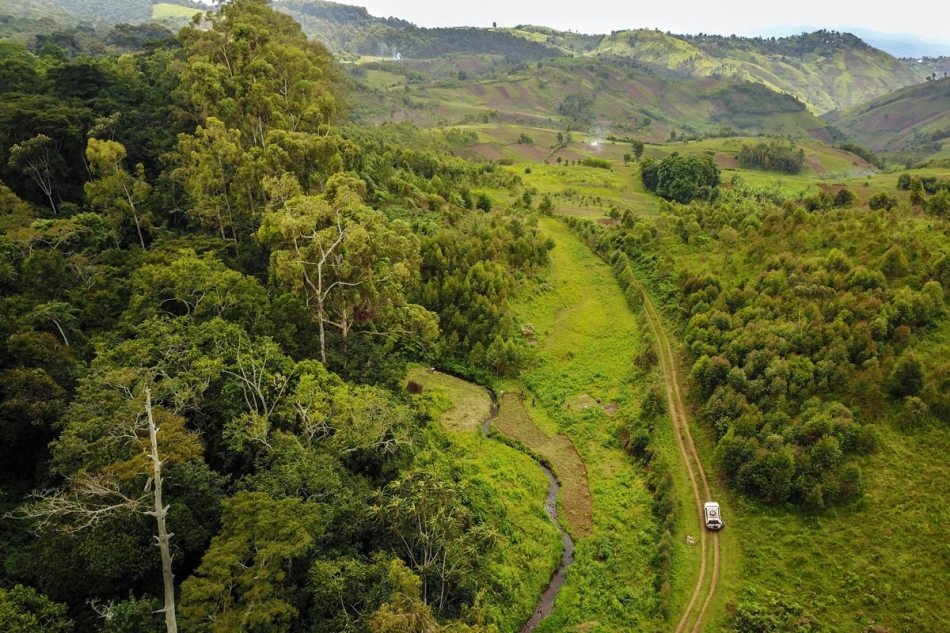Jun 25 2019
According to new research by scientists at Florida State University, thousand-year-old tropical soil unearthed by speeding up agriculture land use and deforestation could release carbon dioxide into the atmosphere.
 Florida State researchers working in the Democratic Republic of the Congo found a link between the churning of deep soils during deforestation and the release of carbon dioxide through streams and rivers. (Image credit: Florida State University)
Florida State researchers working in the Democratic Republic of the Congo found a link between the churning of deep soils during deforestation and the release of carbon dioxide through streams and rivers. (Image credit: Florida State University)
In an exploration of 19 sites in the eastern Democratic Republic of the Congo, scientists found out that heavily deforested regions leach organic carbon that is considerably older and more biodegradable when compared to the organic carbon leached from densely forested areas.
The older, chemically unstable organic carbon, which is unleashed from deeper soil horizons and leached into waterways by rain, is ultimately eaten by stream-dwelling microbes, which demolish the rich compounds and breathe carbon dioxide back into the atmosphere. According to scientists, it is a process that could put local ecosystems at risk and further increase the greenhouse effect.
In many ways, this is similar to what happened in the Mississippi River Basin 100 years ago, and in the Amazon more recently. The Congo is now facing conversion of pristine lands for agriculture. We want to know what that could mean for the carbon cycle.
Rob Spencer, Study Author and Associate Professor, Department of Earth, Ocean and Atmospheric Science, Florida State University
Although the wider impacts of deforestation on the carbon cycle are familiar, investigators stated that their findings, reported in the journal Nature Geoscience on June 24th, 2019, suggest there is a supplementary pathway or leakage of carbon into rivers from soil churned by land conversion and deforestation.
At this point, it’s hard to know the magnitude of this flux and thus the relative importance of this process compared to other anthropogenic sources of CO2, but it is likely to grow with additional deforestation and land-use conversion. We hope this paper stimulates more research into the relative importance of this process.
Travis Drake, Study Lead Author and Former FSU Doctoral Student
In order to better differentiate the range of soils in their research, investigators analyzed the dissolved organic carbon leached from study locations into outflowing streams and rivers. With ultrahigh-resolution mass spectrometry data produced by advanced tools at the FSU-headquartered National High Magnetic Field Laboratory, the research group discovered that the older dissolved organics released from deforested areas were more energy-rich and chemically diverse when compared to those from better-preserved forests.
On the whole, forested regions discharged considerably more dissolved organic carbon when compared to deforested areas. However, the dissolved organics that originated from the deforested and land-converted regions were extremely biolabile, or appropriate for microbial consumption.
“Compositionally, the dissolved organics from deforested landscapes were full of the kinds of things microbes prefer to eat—simpler and easily accessible compounds with plenty of nitrogen,” stated Drake, who now carries out research at the Swiss Federal Institute of Technology in Zürich. “We think the microbial consumption of these old organics coming from soils may partially explain the higher concentrations of CO2 we observed in the deforested area streams.”
In developing tropical areas such as the Congo, deforestation-related soil disturbance has the capacity to significantly improve leaching of organic carbon by rainfall. That loss of organic matter could affect soil fertility and decrease the downstream transport of vital nutrients that sustain aquatic and coastal ecosystems.
On the whole, this process implies that carbon which was safely stored within the Earth for millennia could now be re-entering the modern carbon cycle. As investigators put forward, if that carbon is released into the atmosphere in the due course as carbon dioxide, it could add to the greenhouse effect.
Investigators stated that these findings highlight the importance of identifying the second- and third-order effects of deforestation, land conversion, and the uncontrolled disturbance of deep, nutrient-rich soils in the tropics. Although extensive and systematic forest preservation is the best remedy, the study proposes less disruptive farming practices could also help compensate for some of the destabilization.
“This research focuses on the Congo because the tropics are really at the forefront of agriculture-driven land-use conversion,” stated Spencer.
“Ultimately, it depends on the preservation of forests that maintain and store carbon in soils over longer timescales,” added Drake. “When land-use conversion does occur, better practices such as terracing, use of buffer strips and application of organic residues could ameliorate some of the observed organic carbon leaching.”
Scientists from the Swiss Federal Institute of Technology, Université Catholique de Louvain in Belgium, Ghent University in Belgium, the Max Planck Institute for Biogeochemistry in Germany, the Lawrence Berkeley National Laboratory, The University of California, Irvine, the Université Catholique de Bukavu in the Democratic Republic of the Congo, and the Pontchartrain Institute for Environmental Sciences contributed to this research.
The study was funded by the Winchester Fund at FSU, the National Science Foundation, the Belgian Fund for Scientific Research, the European Research Council, and the European Union’s Horizon 2020 Research and Innovation Program.